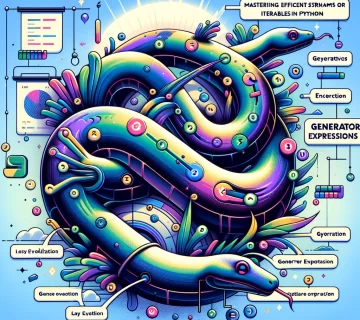Python dictionaries are one of the most versatile and efficient data types in Python. Unlike lists or tuples, which are indexed by a range of numbers, dictionaries are indexed by keys, which can be any immutable type. This key-value pair structure makes dictionaries ideal for storing data that needs to be organized and easily accessible, allowing for fast lookups and an intuitive way to manage data. In this guide, we’ll explore everything from the basics of creating and manipulating dictionaries to advanced techniques and best practices.
Basics of Python Dictionaries
Definition and Characteristics
A Python dictionary is a mutable, unordered collection that stores mappings of unique keys to values. Here, “unordered” means that the items in a dictionary are not stored in any particular order. This characteristic changed in Python 3.7, where dictionaries are now ordered by insertion order, but it’s important to remember that the order is not a feature to rely on for earlier Python versions.
Creating Dictionaries
Creating a dictionary is straightforward. You can create an empty dictionary or one with initial values. Here’s how:
# Empty dictionary
my_dict = {}
# Dictionary with initial values
my_dict = {'name': 'John', 'age': 30, 'city': 'New York'}
Alternatively, dictionaries can be created using the dict() constructor:
my_dict = dict(name='John', age=30, city='New York')
Accessing Dictionary Elements
To access a value in a dictionary, you use the key associated with that value:
print(my_dict['name']) # Output: John
If you attempt to access a key that does not exist, Python will raise a KeyError. To avoid this, you can use the get() method, which returns None or a specified default value if the key is not found:
print(my_dict.get('occupation', 'Not Specified')) # Output: Not Specified
Code Example: Creating and Accessing Dictionaries
# Creating a dictionary
person = {'name': 'Emily', 'profession': 'Artist', 'age': 28}
# Accessing elements
print(person['name']) # Output: Emily
print(person.get('hobby', 'No hobby specified')) # Output: No hobby specified
Working with Dictionaries
Adding and Updating Elements
Adding or updating elements in a dictionary is simple. If the key does not exist, the key-value pair is added; if it does, the value is updated:
person['hobby'] = 'Painting' # Adds a new key-value pair person['age'] = 29 # Updates the value of an existing key
Deleting Elements
You can remove key-value pairs using several methods:
- Using the
delkeyword:
del person['age']
Using the pop() method, which also returns the value of the removed key:
age = person.pop('age')
To remove all items, use the clear() method:
person.clear()
Iterating Over Dictionaries
Dictionaries can be iterated over to retrieve keys, values, or both:
# Iterating over keys
for key in person.keys():
print(key)
# Iterating over values
for value in person.values():
print(value)
# Iterating over items (key-value pairs)
for key, value in person.items():
print(key, value)
Code Example: Modifying and Iterating Dictionaries
# Modifying dictionary
person['location'] = 'New York'
# Iterating over a dictionary
for key, value in person.items():
print(f"{key}: {value}")
Advanced Dictionary Operations
Dictionary Comprehensions
Dictionary comprehensions offer a concise way to create dictionaries from iterable data structures. Similar to list comprehensions, they follow the format: {key: value for item in iterable}. This method is particularly useful for transforming one type of data structure into a dictionary or for filtering dictionary contents.
Example of creating a dictionary with comprehension:
squares = {x: x*x for x in range(6)}
print(squares) # Output: {0: 0, 1: 1, 2: 4, 3: 9, 4: 16, 5: 25}
Nested Dictionaries
A nested dictionary is a dictionary that contains another dictionary. This structure is useful for storing hierarchical data, such as data categorized under multiple levels.
Example of a nested dictionary:
family = {
'John': {'age': 30, 'job': 'Teacher'},
'Jane': {'age': 28, 'job': 'Engineer'}
}
print(family['John']['job']) # Output: Teacher
Merging Dictionaries
Python provides several ways to merge dictionaries. The update() method modifies a dictionary by adding key-value pairs from another dictionary. Python 3.5 introduced a more concise syntax using the ** operator, allowing the merging of two or more dictionaries into a new dictionary.
Using update():
dict1 = {'a': 1, 'b': 2}
dict2 = {'b': 3, 'c': 4}
dict1.update(dict2)
print(dict1) # Output: {'a': 1, 'b': 3, 'c': 4}
Using ** operator for merging:
merged_dict = {**dict1, **dict2}
print(merged_dict) # Output: {'a': 1, 'b': 3, 'c': 4}
Dictionary Methods
Python dictionaries come with a variety of built-in methods that facilitate common tasks, such as accessing, adding, removing, and updating elements. Here’s a closer look at some of these methods with examples:
get(key, default=None): Returns the value for a key if it exists, otherwise returnsdefault.items(): Returns a view object containing the key-value pairs of the dictionary.keys(): Returns a view object containing the keys of the dictionary.values(): Returns a view object containing the values of the dictionary.pop(key[, default]): Removes the item with the provided key and returns its value, ordefaultif the key is not found.update([other]): Updates the dictionary with the key/value pairs fromother, overwriting existing keys.
Code Example: Using Dictionary Methods
contacts = {'John': '555-0101', 'Jane': '555-0202'}
print(contacts.get('Jake', 'No contact found')) # Output: No contact found
# Display all contacts
for name, number in contacts.items():
print(f"{name}: {number}")
# Update John's number and add a new contact
contacts.update({'John': '555-0102', 'Jake': '555-0303'})
print(contacts)
Best Practices and Performance
When working with dictionaries, consider the following tips to optimize your code:
- Use the Right Data Types for Keys: Since keys are hashed to store and lookup values, using immutable types (like strings or tuples) as keys ensures consistency and avoids errors.
- Leverage Dictionary Comprehensions: For creating dictionaries from sequences or transforming lists into dictionaries, comprehensions offer a readable and efficient approach.
- Be Mindful of Memory Usage: Dictionaries can become memory-intensive. When dealing with large datasets, consider the impact on your application’s memory footprint.
- Avoid Common Pitfalls: One common mistake is modifying a dictionary while iterating over it, which can lead to unexpected behavior. Use dictionary methods like
.items(),.keys(), and.values()to safely iterate.
Common Uses of Dictionaries
- Storing and accessing configuration settings or preferences
- Caching results from expensive computations
- Organizing data for easy lookup and retrieval, such as contact books or inventory systems
Common Mistakes
- Attempting to access keys that don’t exist without using
get()or handling withtry-except. - Confusing the use of
update()method, which modifies the dictionary in place, with themergeoperation using**, which creates a new dictionary.
Real-world Applications of Python Dictionaries
Python dictionaries find their use in numerous real-world applications, thanks to their versatility and efficiency. Here are some examples where dictionaries shine:
1. Database-like Storage and Retrieval
Dictionaries can act as a mini-database for storing and retrieving data in key-value format. For instance, managing user information:
users = {
1001: {"name": "Alice", "email": "alice@example.com", "active": True},
1002: {"name": "Bob", "email": "bob@example.com", "active": False},
}
# Retrieve a user by ID
user_id = 1001
if user_id in users:
print(users[user_id])
2. Configuration Settings
Dictionaries are ideal for storing configuration settings of an application, where each key represents a setting name:
config = {
"theme": "dark",
"notifications": True,
"language": "English",
}
# Accessing configuration
print(config["theme"]) # Output: dark
3. Counting Items
Using dictionaries to count occurrences of items in a collection is both efficient and straightforward. This is commonly used in data analysis for counting instances of words in texts, votes in elections, etc.:
words = ["apple", "banana", "apple", "orange", "banana", "apple"]
word_count = {}
for word in words:
word_count[word] = word_count.get(word, 0) + 1
print(word_count) # Output: {'apple': 3, 'banana': 2, 'orange': 1}
4. Caching Results (Memoization)
Dictionaries can be used to cache the results of function calls to improve performance, especially for expensive recursive computations:
def fibonacci(n, memo={}):
if n in memo:
return memo[n]
if n <= 2:
return 1
memo[n] = fibonacci(n-1, memo) + fibonacci(n-2, memo)
return memo[n]
print(fibonacci(10)) # Output: 55
5. JSON Data
Since JSON format closely resembles Python dictionaries, they are extensively used in web development for sending and receiving data between a server and a client:
import json
# Convert dictionary to JSON string
user_info = {"name": "Eva", "age": 29}
user_info_json = json.dumps(user_info)
print(user_info_json) # Output: '{"name": "Eva", "age": 29}'
# Convert JSON string back to dictionary
user_info_dict = json.loads(user_info_json)
print(user_info_dict) # Output: {'name': 'Eva', 'age': 29}
Conclusion
Through this comprehensive guide, we’ve explored the foundational concepts of Python dictionaries, delved into advanced operations, and discussed best practices to optimize your usage of dictionaries. The real-world applications highlighted the versatility and power of dictionaries in Python programming.
Dictionaries are a fundamental part of Python, and mastering their use can greatly enhance your coding efficiency and capability. Whether you’re managing data, caching results, or interacting with web services, dictionaries offer a robust and intuitive way to store and manipulate key-value pairs.
Take the Quiz!
Now that you’ve learned about Python dictionaries, why not test your knowledge with a quiz? It’s a great way to reinforce what you’ve learned and identify areas where you might need a little more practice. Remember, the key to mastering Python dictionaries is consistent practice and exploration. Happy coding!





No comment